Whether you are stuck at home with no access to a washing machine or you just want to cut costs, living off the grid is a very attractive dream right now.
For thousands of Americans, this is something they have already been doing for many years – at least to some degree.
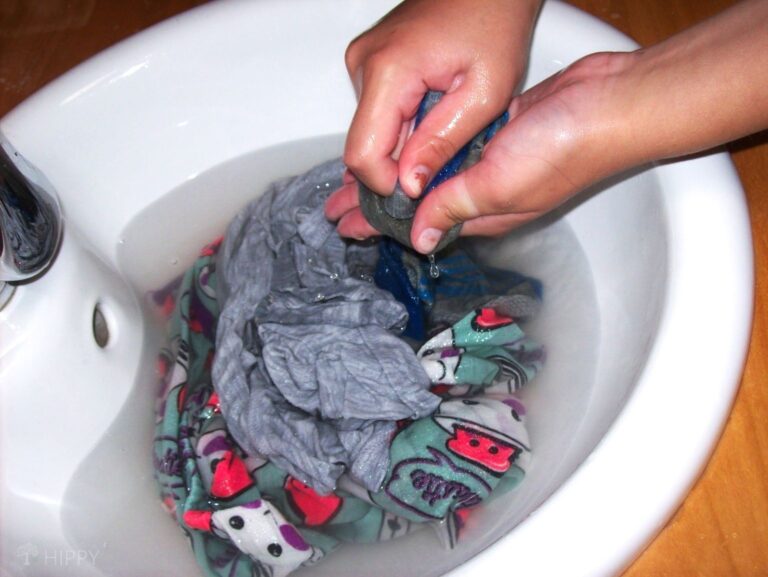
With electricity rates sky-rocketing, power cuts, loss of income, poverty, and an uncertain future, one way to cut costs is by handwashing your clothing.
But let’s face it, handwashing is exhausting work. So how can this task best be done to save you time, money, and effort?
I am going to share my tried and tested ways to wash clothes effectively and efficiently by hand.
I will offer some laundry tips and hacks, and I will show you a few options for portable, non-electric washing machines and even how to build a washer yourself – you will love that section!
You can follow these steps for clean, bright colors and whiter whites with little effort.
Table of Contents
3 Mistakes We All Make
There are two big mistakes we all make when doing our laundry.
First off, detergent is concentrated; using too much is a waste of money, and totally unnecessary. In fact, using too much washing detergent can actually damage your clothes because it can strip away the fibers, and bleach out the color.
The second mistake we often make is to dump the clothes into the basin, then the detergent, and then the water.
By doing this, we are not only not getting the detergent to mix into every part of the clothes we are trying to wash, we are risking destroying the color where we put the detergent.
Always fill the basin first, then add the detergent and mix it thoroughly, then add the clothes. Always run the water into the basin with the detergent agitating the mix to ensure the detergent dissolves properly.
I mix my detergent or softener with a little hot water first to get it to dilute properly, and when everything is diluted, I add it to the washbasin then begin with the washing.
The lighter the fabric the more delicate you need to be.
Third mistake: Avoid scrubbing your clothes. If there are stains, treat them with stain remover and soak before washing. If the stains don’t come out immediately, treat them again, and soak them for longer.
Scrubbing items cause friction that will damage the fibers of your clothing, meaning your clothes will not last long.
Always Read the Label
Always read the label inside each garment for instructions on how to wash it, drying instructions, and water temperature. If you ignore instructions, you could end up with clothes that are faded and stretched out.
You will soon memorize what can be washed with what, and what the ideal temperature for each type of material should be.
Steps to Washing Clothes by Hand
Sort Your Garments
We are so used to sorting clothes by colored or light, but there is so much more that can affect the quality of our efforts.
When you hand wash, a quick sorting before washing can make life easier during washing, and it can protect the fibers of your clothes.
Whether you wash by hand or machine, your clothes rub up against each other causing wear and tear on the fabric.
Don’t just sort your clothes by color. When you sort your clothes, sort by color, fabric, and type of garment.
Remember that you are only going to place one or two items in your washbasin at a time. It is easier to wash similar items together and your clothes will last longer as they are not being mashed with fabric that can clash, damaging the fibers.
Make sure you close all the zippers and that you hook all bras so that they don’t catch on other items and damage your clothes.
To prevent damage to your buttons, undo all the buttons on your garments – especially dress shirts, and remember the buttons on the cuffs and collars.
Prepare Your Washing Area
To put less strain on your back, neck, and shoulders, try to find a place where you can stand to do your laundry.
If you have to use a bathtub or bucket, make sure you have a cushion or a towel to kneel on.
Also, use the time when you are moving laundry from the to wash, to the wash, to the rinse, to the to dry piles to roll your neck and shoulders to free any spasms and prevent any from forming.
To get the best result, it is better to work in a large washbasin, whether that is a bathtub or a large sink, as this will give you more room to work and allow detergent to permeate into the folds of your clothing.
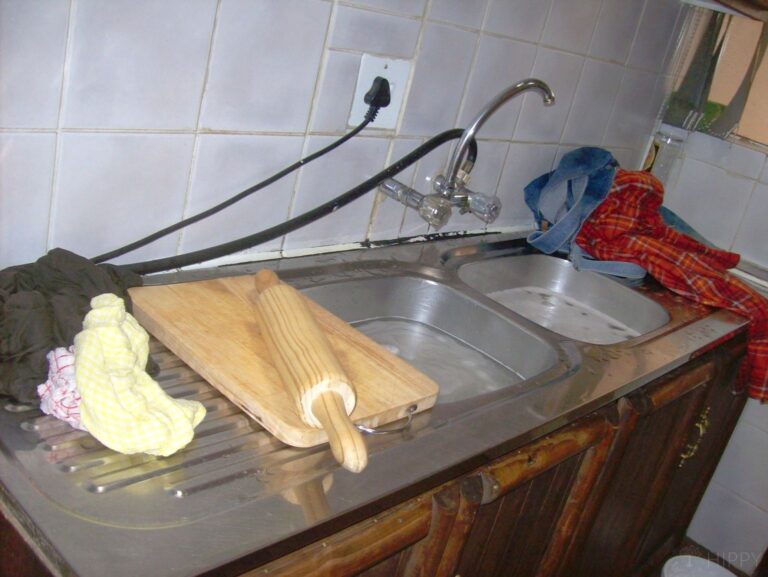
Make sure you have enough room to work comfortably, and then clean all the surfaces around the area where you are working. You definitely do not want to put a clean item down on a dirty work surface when you have just washed it.
Decide where you will wash, rinse, and set items down when they are washed, rinsed, and are ready to be dried.
If you are lucky enough to have two basins in your kitchen or bathroom, you are set. Use one for washing the other for rinsing, and then move them to the clean pile, ready to dry.
Treat Stains
Be sure to treat stains ahead of washing. Check out the tips at the end of this article for how to remove stubborn stains. Never scrub stains, as this will damage the fibers of your clothing.
When treating stains with stain remover or detergent, gently rub a bit of detergent, stain remover, or softener on the dampened area before washing.
It is always best to let clothes soak for 15 minutes to an hour before washing.
You won’t be washing items together, but you can soak colorfast items together before washing to save time.
Add Only One or Two Items To The Basin At A Time
Don’t rush and dump all your clothes in the wash basin at the same time. You will be bent over for longer and you will never get your clothes properly clean. You can soak clothes together, but only introduce one or two items to your wash at a time.
By introducing one or two items at a time you will be able to make sure that every item is properly clean and that no stains remain.
Many people think that doing less or moving less is kinder to our bodies. This could not be further from the truth.
Moving less is what places all the strain on our bodies. By introducing a few items at a time, you are moving around using your muscles, changing your posture, and relieving tension.
This is what is going to ultimately make the difference to an exhausting, often unrewarding, and unpleasant chore versus quick, efficient use of your time and effort to do your laundry by hand.
Wash
Don’t Scrub!
Gently rub articles of clothing together, just agitating the soapy water, and making sure that every part of your garment has been thoroughly cleaned.
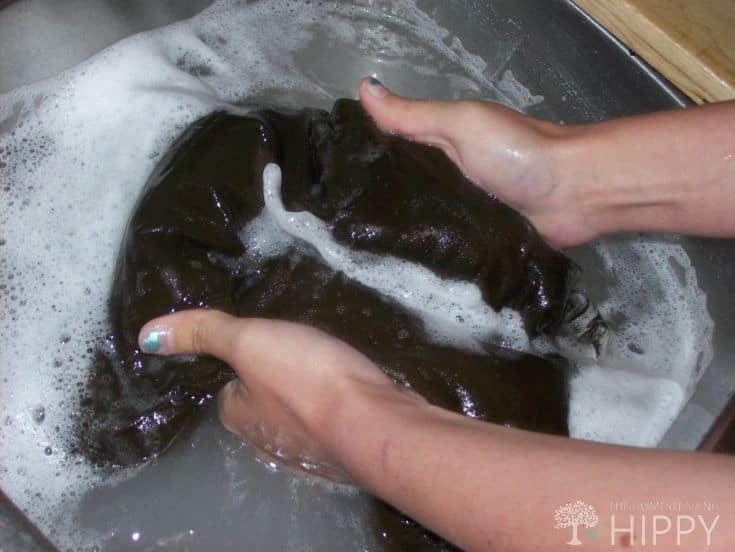
For items like denim, linen, canvas, or hard-to-wash blankets, you will need to put in a bit more effort. But still, make sure you do not scrub the items. Just gently rub them together to remove all the dirt.
Rinse
Do not wring water out of your clothing. Wringing your clothes is what causes them to stretch and lose their shape.
Drain the water from the basin laying clothes flat on the bottom, and just press on them to remove excess water.
Clean the soapy suds out of the washbasin, and add clean water then carefully rinse each item thoroughly to remove soap. You can rinse clothes as many times as necessary to remove all the soap.
Use a rolling pin to remove excess water without damaging your clothes:
Apply Softener
Thoroughly clean the washbasin before you apply fabric softener. Add cold or lukewarm water to the basin, and thoroughly clean the basin. Make sure there is no soap residue in the basin before you add softener to clean water.
Add cold or lukewarm water, and thoroughly mix in your fabric softener.
Once again, take just one or two items at a time and gently swirl them about in the water. No scrubbing, rubbing, or harsh agitating is required. Your clothes are already clean.
Adding softener is to coat fibers in a protective coat, and to give you that fresh, clean, comforting smell we all love.
Rinse Again
Rinsing is an essential part of doing your laundry.
When you wash your clothing and you take it out from the washing, it will still have detergent built up inside the fibers themselves. That’s why you’re going to rinse a second time during this handwashing process!
You need to remove this residue in order to ensure that your clothes last longer and are always clean and in good condition.
If you don’t rinse your clothing properly, you will find that your clothes build up a tacky feeling. They will feel sticky and you’ll find your clothes shedding white powder, which is the remaining detergent as it dries.
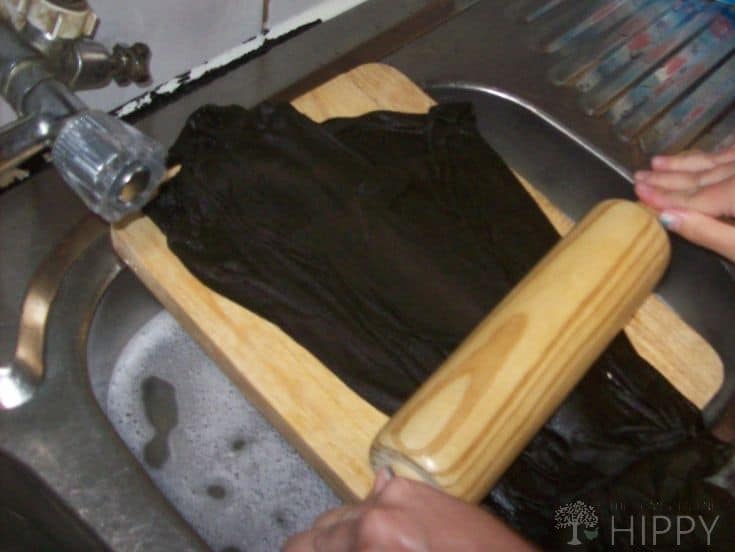
Once you have washed and softened all of your clothing, drain the water out of the basin, and gently press down on items to remove as much water as possible. Do not wring items to remove water. Just press down to remove any excess water.
Remove all the clothing from the washbasin, then clean your basin thoroughly. Make sure that you get all the soap suds out of the basin, then add cold or lukewarm water to rinse your clothing.
Do not rinse clothing under the tap as this will not remove all the soap. You will think the water is running clear so the soap must all be out, but soap always finds somewhere to hide. Your clothes will have sticky, powder residue on them once dry.
Take a few items that are ready to be rinsed and rinse them gently in the water. Just agitate the water enough so that it can circulate through the clothing without making clothing brittle.
If you find the water is still very cloudy, drain the basin again, clean it again and rinse your clothes.
By properly rinsing, your clothes will last longer, feel fresher, and you will be spared the embarrassment of having powder that looks like dandruff on your clothing.
Drain Water And Squeeze Water – Don’t Wring Out!
Remember to never wring your clothing out as this will cause your clothing to stretch and the fibers to become brittle.
Rather lay the garments in the basin and gently press down on them. By laying them in the basin you will not stretch the fabric or cause garments to lose their shape:
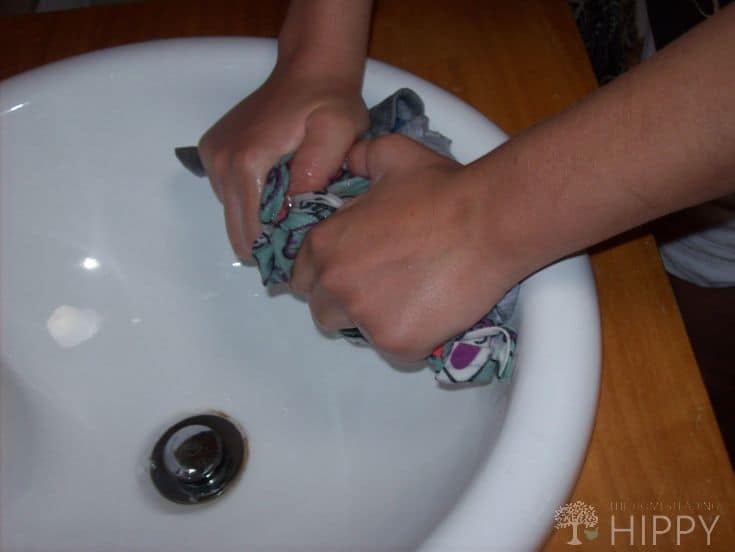
Remove as much moisture as possible. You can use a clean bucket to press down on the clothes to remove water.
Dry On A Towel
For many years I dried my clothing out in the sun, on the washline. Frustratingly, my t-shirts, sweaters, and other garments lost their shape and started to lose their color.
I immediately attributed this to poor manufacturing. In reality, I was not thinking about the basic science of mixing detergent, color, and sunlight.
As children, my friends and I used to mix Sunlight Soap and lemon juice, and rub it into our hair and then sit in the sun, sometimes for hours, to naturally bleach our hair.
It really worked. If you have black hair don’t expect to become a blonde, but it did lighten our hair’s natural color.
The sun is the real active ingredient though. The sun interacts with the colors in your clothing just as it did to our hair.
It naturally bleaches out the color, and if you have not rinsed all the detergent out, this effect is even more profound. It is therefore very important not to dry your clothes in the sun.
Also, hanging clothes on a washline can stretch your clothes and make them lose their shape.
It is better to dry your clothes by laying them flat on the ground in the shade on top of a clean, dry towel to ensure your clothing keeps its shape.
Some items like denim, heavy coats, blankets, sheets, and curtains can be dried by hanging them on a washline. But, again, do not dry them in the sun. Make sure your washline is in the shade.
If you want to keep whites white, then you can dry them in direct sunlight. The sun will bleach out any color that has crept in.
Washing Clothes With Your Feet
If you are looking for a way to go off the grid, the first thing you should do is look to third world countries to see how their locals live without access to power or running water.
People are often forced to wash their clothes by hand in rivers and dams. These people are robust, creative, and innovative. They have life-hacks for almost every backbreaking task you can think of.
In open air washing areas in India, people use their feet to agitate the water by stamping on clothes in big baths. I do this for washing my bedding and curtains. If I tried to hand wash these, I don’t think I would be able to walk for a week from the back strain.
What you can wash with your feet:
- curtains
- blankets
- bedding sheets
There are areas in China where residents are forced to do their laundry in rice paddies or rivers. In one of the most advanced societies in the world! Modern luxuries like running water and electricity are alien in many rural parts of China.
I fill my bathtub with water, add detergent, then I add the blankets, then I climb in and gently walk about on the item I am washing. I flip the item a few times to be sure I get to every spot:
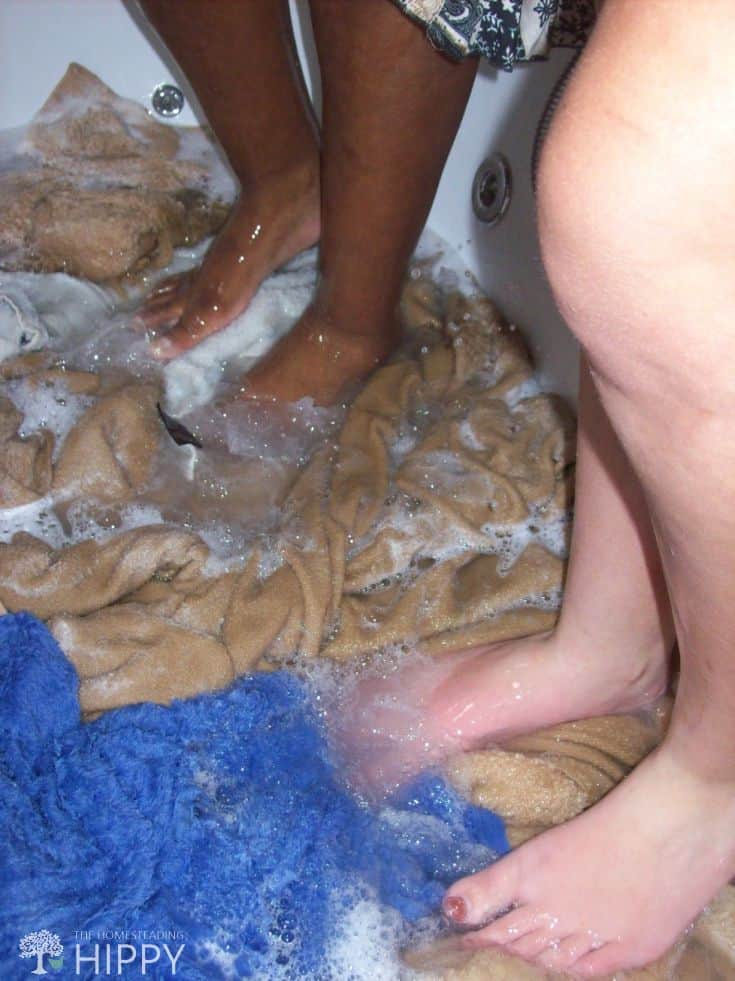
Squeezing the water out is just as easy:
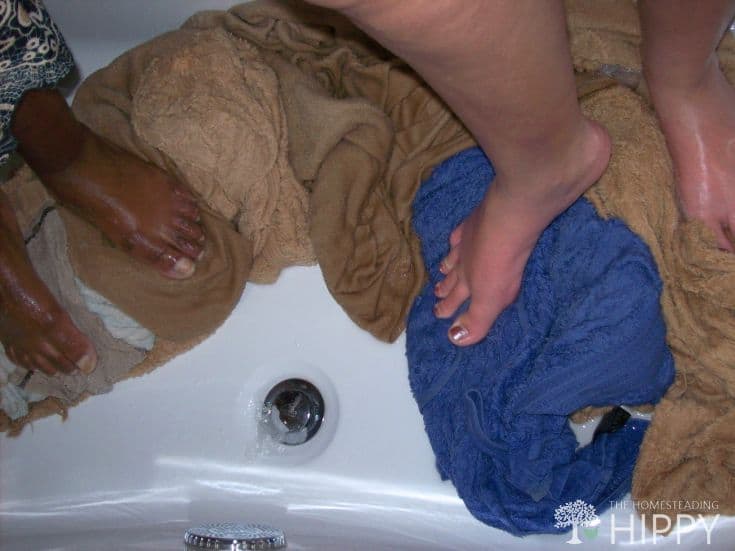
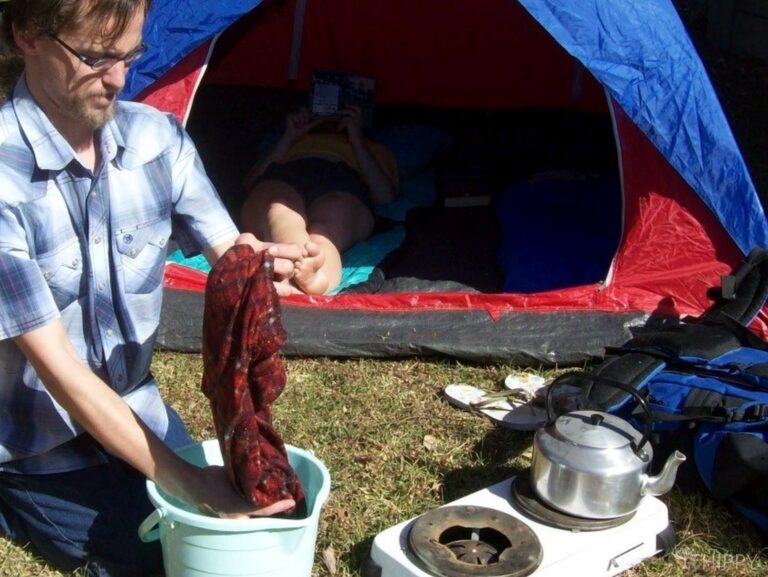
Doing Laundry by Hand While Hiking or Camping
The humble bucket is a camper’s best friend. But there are a few extra ideas to consider for camping and even hiking. Look for containers that can be used to do laundry, wash dishes, clean salad ingredients, and even drink from (the tap is great for draining water).
But if you want something dedicated to hand-washing clothes on the go, there are a few good options…
When you visit a link in this article that takes you to a different website where you can purchase something, I may earn a commission. Read my full disclosure for more details.

Option #1. The Scrubba is a very portable bag that you add your detergent, water, and laundry to and just squeeze the bag to agitate the contents.
Inside the bag are small nodules that work to gently release dirt from your clothes.
This is a hiker’s best friend. It does not cost much, it is lightweight and portable, and it can be used to hold items while you hike.

Option #2. If you enjoy day trips and short hikes, the Scrubba Stealth Pack – Multifunctional Backpack – Waterproof Backpack, Portable Washing Machine, Compression Dry Bag, and Camping Shower All in One is a truly portable washing machine you will love.
This multifunctional backpack can keep things dry, wash clothing, remove water from wet clothes, towels, etc., and be used as a shower. It also has the nodules that agitate dirt out of your laundry.
There are a few portable washboards that are lightweight and fully portable. These are great for doing laundry in rivers.

Option #3. The Inomata Laundry Board is perfect for hikers. It weighs just 1.6 ounces and is made of durable plastic.
When you use a washboard, don’t go overboard with scrubbing. It does not require major effort, just enough to release the dirt.
Laundry Hand-Washing Tips
- Using a bucket intended for pouring water and cold drink is an easy solution for draining water. Just open the tap at the bottom of the bucket, and let the water drain.
- Use a rolling pin to remove excess water without damaging your clothes.
- Use hairspray or hand sanitizer to get rid of ink stains.
- To brighten faded whites, boil lemons that are cut up, add to your laundry in its soaking water and leave it to soak for 20 minutes.
- Always read the tags on all your clothes and wash them accordingly.
- Grease stains are easy to remove by simply rubbing chalk (like the chalk used in the classrooms of yesteryear).
- You can use a salad spinner to hand wash your delicates.
- Mix vinegar and the essential oil you love the most as a fabric softener. It is delicate and will leave your clothes smelling wonderful.
- Dry your whites in the sun. The sun will help bleach them naturally, leaving them looking like new for longer.
- Keep mesh bags in everyone’s rooms for underwear and socks. They can be washed in the bags ensuring that everyone gets both socks back.
- Use a sweater stone to remove excess fabric pilling from your favorite sweater.
- Avoid hand washing silk garments that are patterned or vibrantly colored – the colors may bleed. There are other kinds of clothes, like delicate lingerie and baby clothes, that may have special requirements, too – so make sure you check the instructions before you start.
- Washing wool? Use a detergent that has lanolin. Lanolin is a natural oil produced by sheep and helps them waterproof their fleece coats. It will make wool garments softer when you hand wash them.
- Try not to overcrowd the sink with too many clothes. You’re best off washing just one or two items at once. Similarly, you should over soak the garments, as allowing them to soak for too long can cause them to fade and can also cause damage to things like sequins and embroidery.
- If you’re trying to dry hand washed garments in a hurry, avoid placing delicate items in the dryer. You’ll undo all the hard work you just did!
- Always sort your garments by color and fabric type, and avoid hand washing light and dark colors together – there’s a good chance that the dark ones will “bleed” dyes and stain the lighter ones.
- Clean your sink! This should go without saying, but if you’re handwashing your clothes in the sink or bathtub, take the time to give it a good cleaning first. You don’t want to find remnants of last night’s dinner all over your “washed” clothes.
Know How to Wash Specific Garments
As you’ve likely already gathered from reading this article, washing your clothes by hand is tough, tough work.
However, knowing how to do so correctly will not only help your clothes last a lot longer, but it will save you time and money, too. Plus, it’s much better for the environment.
Any kind of garment can be washed by hand, but not all garments should be hand washed in the exact same way. There are unique considerations you will want to make when it comes to washing different kinds of clothes.
Before you do anything, check the instructions and the label for that particular garment.
I’ll give you some advice on how to wash certain types of garments below, but ultimately, what the label says, goes. If it says dry clean only, don’t try to wash it by hand – even if you’re super gentle.
Also, before you hand wash anything, take the time to check a small section to make sure the fabric won’t leach colors. Choose an inconspicuous area and remember that certain kinds of fabrics may require special care.
Washing Bras and Delicate Lingerie
Bras are some of the most common items that people hand wash. Here are tips on how to do it.
First, fill the sink with lukewarm water. Add a mild hand washing detergent and mix it in, then add the bra and let it soak for fifteen minutes. Use your hands to knead the suds into the bra.
Then, take the bra out of the water and hold it under the faucet. Let water run over it and rinse out any soapy water.
To dry, fold your bra flat against a towel and press out excess water. Lay another towel on top and press again, then hang to dry.
Washing Sweaters
You may have to follow different steps for wool sweaters or those made out of other fragile materials, but for the most part, you can easily hand wash your sweaters by following these simple steps.
Start by filling up a sink with lukewarm water and a few drops of dishwashing soap. Add about half a cup of white vinegar. Then, turn the sweater inside out and soak it in the water.
You can swish it gently in the mixture but make sure you don’t stretch it. Allow it to soak for ten minutes, then run cold water over it until no more soap remains.
After it has soaked for a while, press the sweater against the side of the sink. Lay it on a towel on a flat surface, then roll the sweater and towel together to get rid of extra water.
Let it dry on a flat surface to allow air to circulate but keep it away from heat and sun. Once it’s dry, you can guide it back to shape by squaring the shoulders.
Washing Underwear
Just like bras and delicate lingerie, there are some styles of underwear that should only be washed by hand.
Start by filling a sink with warm water and use a gentle detergent. Allow it to dissolve, then place the underwear in the water. Let it soak for up to 30 minutes. Swish the detergent around to make sure it’s totally dissolved.
Then, rinse with lukewarm water. If you can, use the sprayer nozzle on your sink to make sure the water really blasts out the soap.
Otherwise, just fill the sink, immerse the underwear, and squeeze the water through. Remove it, squeeze to remove excess water, and towel to dry. You can then hang it or dry it flat.
Washing Baby Clothes
When it comes to hand washing baby clothes, there are very few baby clothes that won’t benefit from the occasional handwashing. In fact, it’s a great way to save on laundry costs and protect your baby’s sensitive skin.
While the specific instructions for hand washing baby clothes will vary depending on the type of garment and the fabric, in general, you can do so by filling a sink with cool water and just a teaspoon of detergent.
Let the clothes soak for 10 to 20 minutes and switch them around gently in the water. Do not twist them, as this can cause them to become damaged.
Rinse under cold water, then lay flat to dry.
Washing Jeans
Jeans can be challenging to wash by hand – not just because they take up so much space but because they also seem to take forever to dry!
However, you can make quick work of it by using cold water and just a small amount of detergent. Swish the water around with your hands to make it soapy, then submerge the jeans.
Let them soak for ten minutes, then drain the sink and refill with cold water. Rinse as best as you can, then wring them out. Hang them flat to dry.
Washing Silk and Lace Fabrics
You can hand wash silk and lace garments by following the steps listed for the other garment types.
However, the key to washing these kinds of clothes by hand is to choose a detergent that requires no rinsing. This will make cleaning the clothes easier and will also protect the clothes from any damage.
Washing Tights
Tights are good garments to know how to hand wash, since they are easily destroyed by the agitator in a washing machine. Here’s how to do it.
Start by filling the sink with lukewarm water, then add half a cup of your favorite mild laundry detergent. One that’s intended for delicate clothes will be best.
Make sure the water isn’t too hot before you begin, as hot water will make your tights less elastic and can cause them to sag as you are wearing them.
Then, turn your tights inside out. Put them in the water and scrub gently. Try not to pull or rub so that you don’t have to worry about snags or tears.
Just work gently, paying special attention to bacteria-prone areas like the feet and crotch. Let them soak for another fifteen minutes.
Then, remove the tights and rinse under cold water until no suds remain. Roll them into a ball and squeeze out the water. Put them on top of a towel then lay flat to dry.
Quick Tips and Hacks for Handwashing Clothes
Looking for an easy laundry hack for washing your clothes? Here are some tips!
Use Baby Shampoo to Treat Sweat Stains
Baby shampoo is great for more than just washing babies! It can also be used on adults’ clothing too. Use it to treat sweat stains by rubbing a small amount onto the stain before soaking in cold water.
…or to Un-Shrink Sweaters
You can also use baby shampoo as an effective way to un-shrink sweaters that were accidentally thrown into the dryer. Simply rub baby shampoo into the fabric and then soak in lukewarm water for 15 minutes before laying flat on a towel to dry.
Use Baking Soda and Vinegar on Your Towels
If your towels are looking dull or feeling stiff after being washed, add some baking soda and vinegar when you rinse.
The combination of baking soda and vinegar helps break down detergent residue while softening your towels at the same time. This hack is perfect if you don’t have fabric softener handy!
Cut a Pool Noodle Around Your Drying Rack Rod to Dry Clothes Without Creases
Don’t have enough room for an ironing board or want an easier way to dry clothes without having them look wrinkled?
Cut up some pool noodles (or foam tubes) and slide them around your drying rack rods for crease-free drying every time! This is especially helpful if you’re trying to dry delicate items like baby blankets or dresses that are prone to wrinkles.
Presoak Your White Clothes with Chlorine Bleach …Or Use Hydrogen Peroxide Instead of Bleach
Chlorine bleach is a great way to keep whites looking their whitest – but did you know that hydrogen peroxide can do the same job without harsh chemicals? Add ½ cup of 3% hydrogen peroxide during the presoak cycle when washing white items.
This will help brighten whites while keeping them safe from bleaching agents like chlorine that can damage fabrics over time.
Kill An Unpleasant Odor With White Vinegar
Vinegar to the rescue once more! This is an especially helpful tip for those laundry items that tend to get particularly stinky, like gym clothes or barn workwear. Just soak your items with a half cup of distilled white vinegar.
Not only will it kill any lingering smells, but it will give them a boost of softness and brightness, too.
And if you’re worried about the vinegar smell hanging around afterward, just give another rinse with warm water afterward.
Use a Mesh Laundry Bag to Wash Your Socks
Here’s another simple laundry hack to know about.
Add all your socks into a mesh laundry bag before putting them in with other items, so they don’t get lost among other pieces of clothing (and so they aren’t a huge pain to wash).
This also prevents snags from clothespins when you hang the socks up on the line outside later on!
Final Thoughts
By making your own DIY washing machine and starting to wash clothes without electricity, you will have learned a lot about yourself.
You will have learned to save both time and money. You will have learned great life hacks, and you will be more self-sufficient than ever before.
I hope that you have enjoyed this article and that you find value in the guidance given. But most of all I wish you good health, and clean laundry.
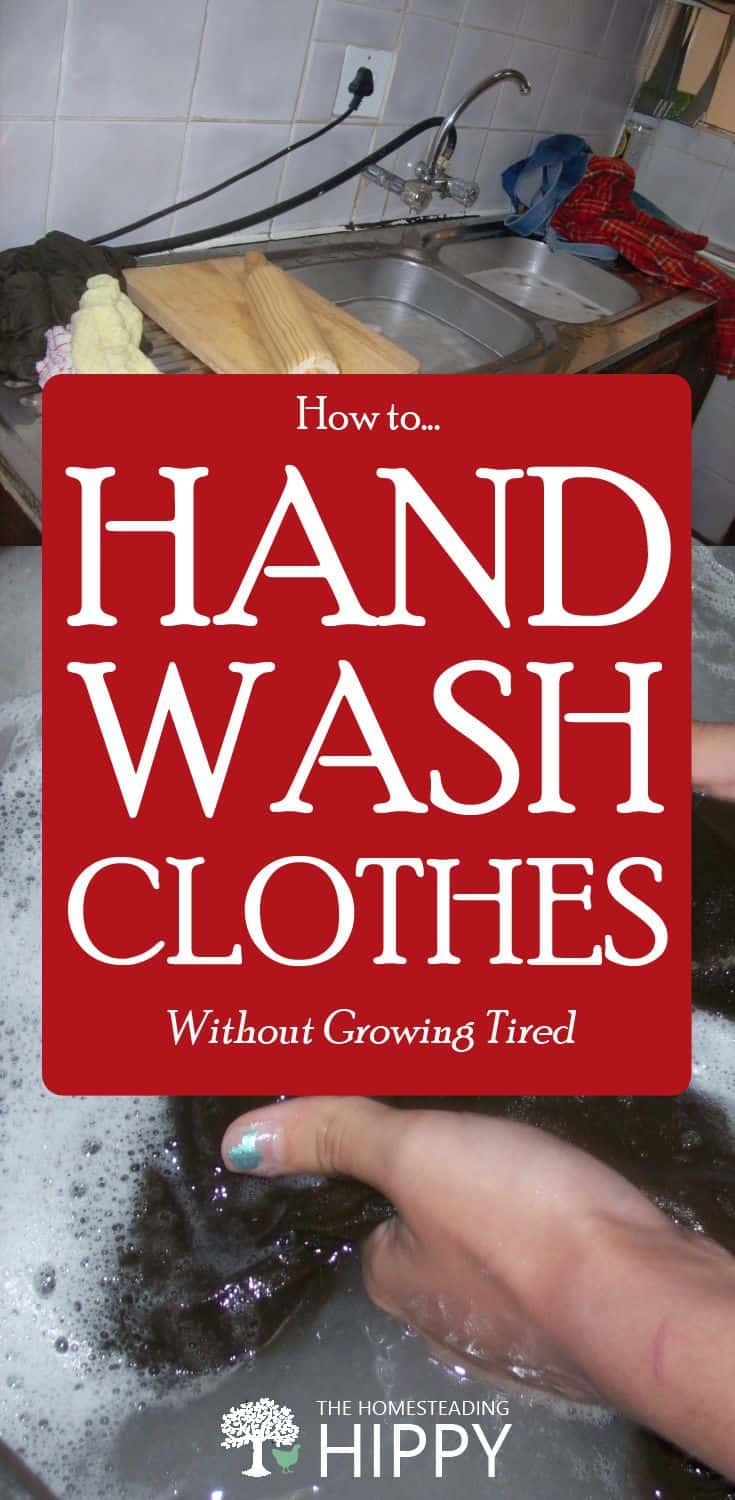

Di-Anne Devenish Seebregts was raised in an environment where daily life consisted of hiking, environmental conservation, growing fruit and vegetables, and raising poultry for meat and eggs.
She combined her passion for the writing word with her love of the pride that comes with not relying on others. She raised three children (who are now adults) to value the environment, and understand the value of being self-sufficient.
Find out more about Di-Anne on our About Us page.
